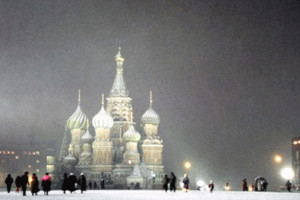A Winter Of Discontent For Russia

(Oilprice.com – Colin Chilcoat – August 25, 2015)
Winters are the stuff of legend in Russia and – despite a fair bit of warming – winter 2015/16 is shaping up to be one of the harshest, and most formative, in recent memory.
After a brief period of respite – and muted acceptance of the “new normal” – to start the year, Putin and company again face a colossal economic mess. From worst to first and back again, the Russian ruble continues its volatile post-Crimea journey. It’s surprise run as the world’s number one performing major currency is long gone and the ruble has collapsed nearly 25 percent since the end of May, and 11 percent alone in August. For optimists and pessimists alike, speculation on the ruble’s future is an exercise in futility. To be sure – on its current path – it’s not a very fun activity either.
On a micro level, the ripple effects have hit hard. Real wages, or purchasing power, fell 4.8 percent in July and dropped 9.2 percent compared with the same period a year ago. Disposable income is also down 2.9 percent on the year. Unemployment remained steady, but an increasing number of workers are not getting paid; the amount of salary in arrears climbed 6.2 percent in July. Further, there is talk of delinking pension hikes from inflation, a move that would condemn a growing number of the population to abject poverty should the economic trends continue.
More broadly, the recession is in full swing. Russia’s gross domestic product slipped 4.6 percent year-on-year in the second quarter – a fall that makes it the worst performing mid-sized economy in the world, ahead of Iraq and Venezuela. Negative growth in 2016 is looking more and more possible and Bank of Russia economists estimate that western sanctions have lowered the GDP ceiling by as much as 0.6 percent this year.
Energy export revenues have obviously tanked, but longer-term sources of growth are also proving elusive in the current climate. Capital expenditures in industrial production and infrastructure are down and continue to fall. Conversely, capital flight may reach $90 billion by year’s end.
It’s quite apparent that a business-as-usual approach spells trouble for Russia; minus some budgetary magic, or a swift oil price turnaround, the reserve fund may dry up within a year. The solutions are not abundantly clear, but, for the first time in a long time, the costs of changing an inefficient status quo – Russia’s institutional trap – may finally outweigh the benefits of its existence.
Grumblings of discontent at the top have been quick to surface. President of the struggling Russian Railways Vladimir Yakunin is out – apparently of his own volition – and other CEOs, Rosneft’s Sechin and Gazprom’s Miller included, may see their tenures cut short in the name of greater efficiency.
America in 2017: Warren Buffett’s Bold Prediction
Bailout legislation currently in the works aims to reduce the strain on nationally significant companies, but the list of suitors far exceeds the available capital. It is unclear whether or not Gazprom and Rosneft are among the early applicants for aid, but Putin has promised that current and future supply projects, and foreign contracts, will not be threatened.
Toward this end, a push for technological and operational independence has been prioritized. Baker Hughes has entered into a partnership with Novosibirsk State University on the modeling of oil fields; GazpromNeft is developing its own forecasting software; and the government is working to provide import-substituting producers with the appropriate financial levers for success. Still, both cost- and time-intensive, this is a long-term contingency plan that few can count on.
For its part, foreign experience will continue to play a major role. Halliburton’s Sperry Drilling, C.A.T.Oil AG, and Schlumberger are just some of the companies taking advantage of the increased demand for horizontal drilling in conventional plays. Rosneft will look for its newest acquisition, Trican Well Service, to provide similar, production enhancing, services.
Further, a draft bill seeks to open up large deposits of oil and gas for exploration – a tacit admission that the old, and oft-changing, mineral regime did little to spur greenfield development. However, interest in the blocks, previously off-limits to foreign producers, is hardly encouraging.
Maintaining output and market share amid low demand and low prices remains the goal du jour. And, to be sure, the oil and gas will keep flowing – there’s no other option. But, for the people at the top, and the people on the ground, it’s going to be a long winter.
